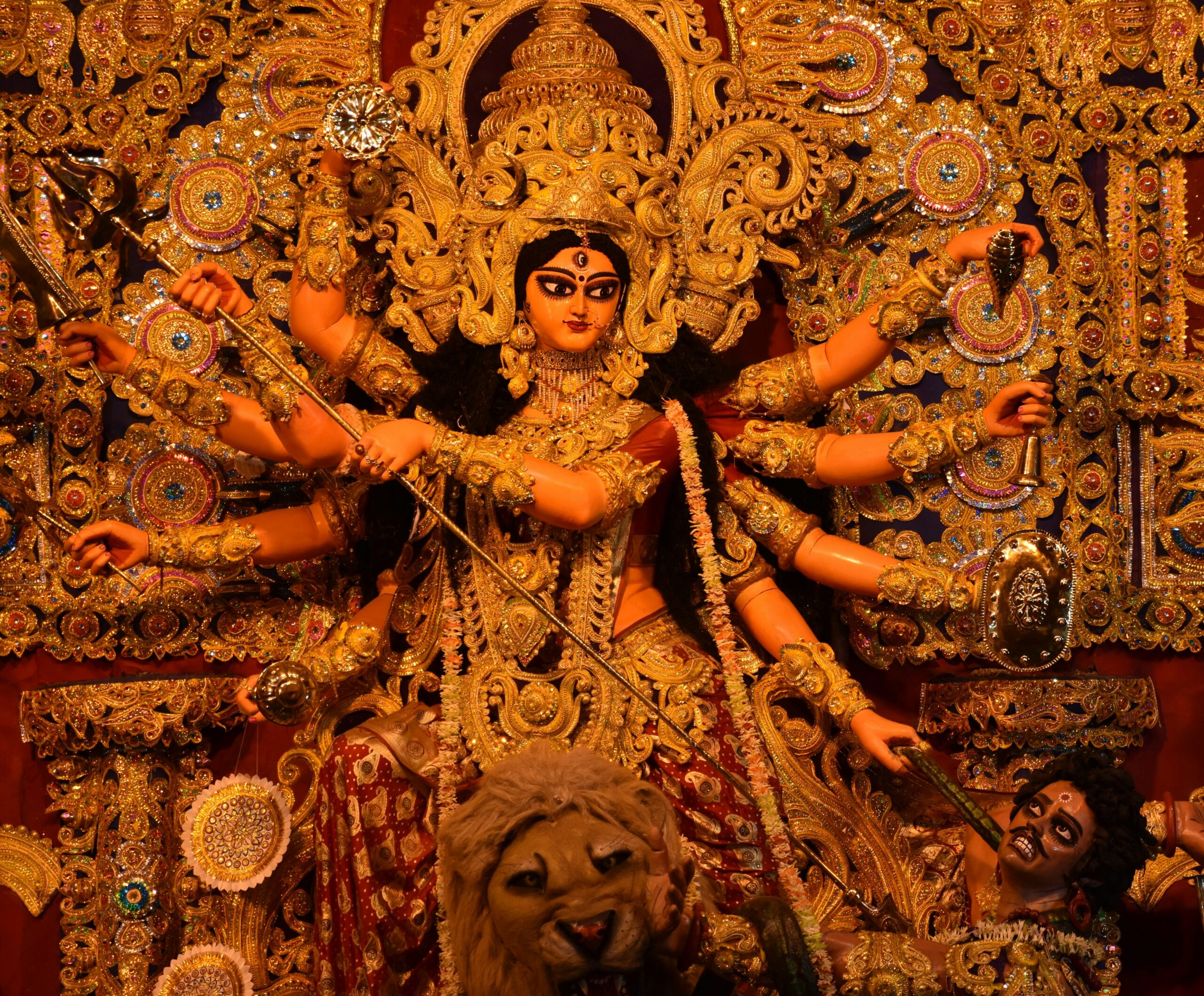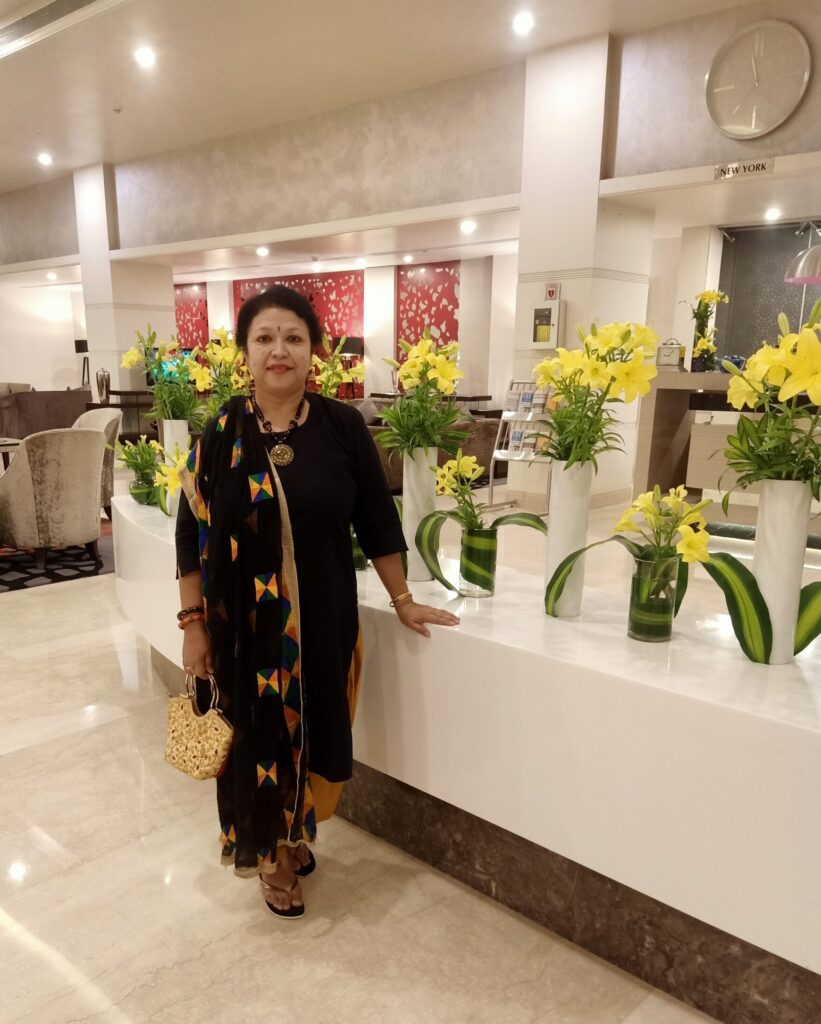This article was published on Women’s Web in October, 2023.
It was that time of the year again. The season of lights, crowds, and unending festive cheer. The much-awaited time when the city of Calcutta effortlessly donned its cherished mantle of Kollolini Tilottoma – a surging, bustling entity, almost human in nature, embodying eternal beauty and liveliness. It was Durga puja time!
Most of the neighbourhoods resembled a carnival site with fairy bulbs strung across the length and breadth of the roads, lighting up every concrete and natural structure. Loudspeakers blaring devotional music set the mood for the upcoming five days of worship. The commercial zones were choc-a-bloc with last minute shoppers, eager to team their outfits with trendy footwear and jewellery. Police personnel stepped up their vigil, manning every nook and cranny, to ease the burgeoning traffic.
Welcome to Sonagachi!
Far from the hustle of the city, lay a neighbourhood where hectic efforts were underway to welcome the goddess on her annual visit to the earth. The reason for celebration was the same – only, the ambience was different. Welcome to Sonagachi — South Asia’s largest red-light area, located in North Calcutta. Housing several multi-storeyed brothels and providing shelter to almost sixteen thousand sex workers, the very name Sonagachi evokes varied responses from the general public – from sniggers and guffaws, to lewdness and raunchy innuendos, to plain disgust and dismissal. These women live here not by choice – it is dire circumstances and the absence of other means of sustenance that have dragged them here. The garish outfits, the loud make-up and tacky trinkets are flaunted with the sole purpose of attracting prospective patrons. Which, in turn, translates into an income. To borrow a hackneyed slogan to describe this hotbed of carnal interests – love it or hate it, you cannot ignore it!
Sonagachi has been celebrating Ma Durga’s yearly homecoming since 2013. Obtaining the license, or the permission, to host the event was a milestone in itself, for this neglected community of women. According to the residents here, the path to procuring this permission was fraught with multiple civil and legal hurdles. It was a prolonged and tedious battle for these petitioners who had neither the financial resources nor the much-needed political clout and social backing to expedite matters. However, in a strange manifestation of the triumph of truth, the roadblocks were finally cleared and thereafter, there was no looking back. It has not been a smooth ride for the hosts – in fact, far from it. But these women have continued the legacy of celebrating this autumnal festival undeterred, and with boundless enthusiasm and religious fervour.
An Unholy Alliance
The just concluded 2023 Puja celebrations were in the news for a largely unique reason. The theme this year was – Amader Pujo, Amrai Mukh. Loosely translated, it means ‘it is our Puja and we ourselves are its face’. No high-flown rhetoric here, no poetic jargon, just a hard-hitting, prosaic statement. Nonetheless, it managed to grab eye balls. It made the staid Calcutta bhodrolok (gentleman) sit up and take note. It prompted journalists and bloggers to visit these dark, dingy alleys of shadows and secrets, and speak to these women. To find out the rationale behind this rather unlikely tagline. And what emerged from these conversations was a rather disappointing (but not entirely unexpected) truth.
Months before the actual ten-day events happen, the groundwork for organisation and coordination begins. Organisers of various puja committees go out of their way to network with the well-known names of the world of performing arts. Authors, singers, painters, folk artists, even politicians, sports and trade bigwigs, and of course, the who’s who of the film industry are in huge demand for gracing and inaugurating the community pujas. Committee members make a beeline to get a nod from the celebrities – the bigger the name, the greater the fanfare, and larger the footfall. All combined, they lead directly to augmented media coverage, an award or two, and the accompanying financial benefits. The celebrity, in turn, gets splashed all over social media and news channels. It’s a symbiotic alliance…a win-win situation for both the host and the celebrity guest. As a layman, we never bat an eyelid while cruising down the city flyovers to see the billboards screaming celebrity names, and mentioning the puja they are about to inaugurate. It’s all so routine. Until a tagline or a news article like this, jolts us out of our carefully cultivated sense of certitude.
Lip Service Versus Actual Intentions
A few members of the Durbar Mahila Samanwaya Committee, a collective of some 65,000 sex workers in West Bengal that looks after various needs of its community, revealed the reason behind it. Apparently, in spite of their Puja banner fluttering tall and proud at several vantage points in the city…in spite of the covert curiosity it generated among the public…in spite of the Durbar office bearers approaching multiple public figures, not a single one of them agreed to be their brand ambassador. Speaking ruefully, the women averred that a few of them had even promised to consider the proposal. However, the final outcome remained the same – the dates were clashing either with a prior work commitment (surprise, because the entertainment industry remains mostly shut during these days) or a bash with the family, or a day out with the fraternity folks. But beneath the veneer of inability and regret, the writing on the wall was clear — no one was willing to align with a community that stood on the dubious and unsteady foundation of human prostitution and loose morales. The underlying factors of desperation, poverty and helplessness were, of course, conveniently brushed under the carpet. Displaying fake sympathy, mouthing inspiring platitudes, citing examples of their much-publicised charitable deeds, they silently and unobtrusively sneaked out of what was arguably a very tricky situation for any celebrity.
Listening to the Durbar members speak with a quiet conviction and composure, one is tempted to question the clear discomfiture of our reputed artists and performers when it comes to associating themselves with these so-called ‘fallen women’. What is it that debars them from walking the less taken path? And it is not just our public figures who shy away from including these forsaken women in their dialogue. The general public, too, is guilty of toeing this line. On one hand, we worship the essence of womanhood these nine days. We liberally sprinkle our conversations with woke expressions like women’s empowerment and emancipation, social equality, inclusivity, and respect. And on the other, we consciously and deliberately turn a blind eye to the hopes and aspirations of a large chunk of women, as if they do not exist. We brand them as permanent outliers even at a time when the entire country chooses to rise above all barriers and celebrate as one united community.
The Irony of Punya Mati
Here, one is reminded acutely of the centuries-old practice of initiating the idol-making process with clay taken from a prostitute’s threshold. In Bengal, it is believed that a clump of soil from outside a prostitute’s house has to be begged for, and not demanded. The matron of the brothel hands it over to the priest or the potter, which is then used for making Ma Durga’s idol. Apparently, the men who visit these quarters leave their values and virtues outside the main door, thus making the soil morally rich and virtuous – hence the name ‘punya mati’. However, a month later when the actual celebrations begin, the same women are denied permission to offer prayers and worship the Devi. They belong, after all, to the nishiddho polli (forbidden zone) – how can they possibly stand shoulder to shoulder with the mainstream, respectable devotees? Can anything be more ironical than this? Isn’t this one of the biggest examples of patriarchy and privilege in the religious ambit?
What is it that forces us to maintain such double standards? Why do we do a quick turnaround when faced with a daunting real-life scenario that begs us to practise what we preach? Is it our porcelain ego that threatens to crack at the slightest rumble of a brewing social storm? Or perhaps, sitting in our tall ivory tower of advantage and entitlement, we lose sight of those who are still struggling to find a toe hold in this indifferent world?
A Pan-India Pattern
This Durga Puja incident of Bengal is not an isolated, one-off episode. During my freelance tenure with a reputed web-based media house, I had come across similar cases reported from various parts of the country where sex workers faced either harassment and exploitation, or complete indifference and disregard, whenever they tried to break free of their profession and venture into something new. Be it arranging finances to set up a beauty parlour, procuring a housekeeping job at a corporate firm or private apartment, or even being recruited as a municipality safai karmachari. Their children, too, had to bear the brunt of this insensitive, draconian trend as they were refused admission to established schools – private or government – even though the mothers promised to bear the expenses. And this pattern continues.
Strangely, no one actually speaks it out. There is no written document that issues a refusal or denial. It is all conveyed through carefully worded verbal communication or even through indirect, non-verbal modes. In most cases, the other party does not care to respond or follow up the dialogue. The alienation is covert and complete…the silence of the lit world, deafening.
The Triumph of Feminine Power
These are, probably, startling facts for the uninitiated, the unversed – but for the long-suffering denizens of Sonagachi, this is routine. Bearing decades of neglect, ostracization and a peripheral existence, they, by no means, feel surprised or suppressed. They practise what is, arguably, the world’s oldest profession. And the most abhorred and despised one, too. But as they say, adaptability and change are the biggest game changers to ensure survival in a world robbed of scruples. Similarly, the sex workers of Sonagachi have decided to spin their disadvantage on its head and use it as a tool to empower and entertain themselves. They have declared to the world in one explicit voice that this commemoration of the Goddess is exclusively their own, and that, they are their own brand ambassadors. Unfazed by the glitz, the media spotlight, the fancy pandals and the sophisticated visitors spotted in the upper echelons of society, Sonagachi revels in the spirit of courage, perseverance and intrepidity of its womenfolk. They may be poor and earthy, their attire and make-up may not boast of designer labels, but their hearts are rich in piety and purity.
Amader Pujo, Amrai Mukh – through this loaded, pithy caption, the women of these forgotten fringes have univocally managed to deliver a cogent and compelling response to all those who doubted their physical ability, their moral adequacy, and their social standing, to host an event of such grand magnitudes. The rituals were followed to a T and the devotional fervour remained intact. Most importantly, they were able to enjoy a few days of unsullied joy and gay abandon, away from the dark recesses of human desperation. The condescension of the well-heeled populace failed to dim their celebratory vibes, as these shunned and condemned women of Sonagachi – considered an epitome of ‘otherness’ – became the face of divinity, of freedom, and of the triumph of feminine power.
PC: Tanuj Adhikary on Unsplash
Why Can’t Sex Workers In Kolkata’s Sonagachi Have The Same Right To Celebrate Ma Durga?









